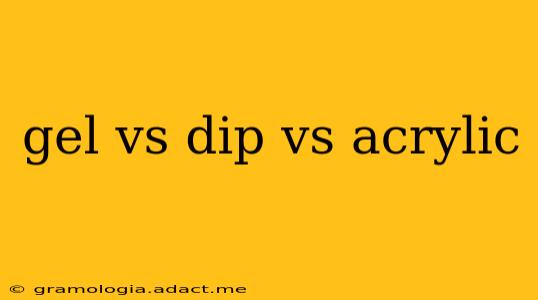Choosing between gel, dip, and acrylic nails can feel overwhelming. Each offers a unique set of advantages and disadvantages, impacting longevity, cost, and overall nail health. This comprehensive guide breaks down the key differences to help you make the best decision for your nails.
What are Gel Nails?
Gel nails utilize a special type of UV-cured resin that's applied in thin layers. Each layer is cured under a UV or LED lamp, hardening the gel and creating a smooth, glossy finish. Gel manicures are known for their relatively natural look and feel, offering a more flexible and less bulky result compared to acrylics.
Advantages of Gel Nails:
- Natural Look and Feel: Gel manicures tend to look and feel more natural than acrylics.
- Shorter Application Time: Generally quicker to apply than acrylics.
- Less Damage to Natural Nails (Potentially): When applied and removed correctly, gel is less damaging than acrylics.
- Variety of Colors and Finishes: Available in a wide array of colors, finishes, and designs.
Disadvantages of Gel Nails:
- UV Exposure: Requires UV or LED lamp exposure, which may have long-term health implications (though research is ongoing).
- Soaking Removal: Requires soaking in acetone to remove, which can dry out nails if not done properly.
- Can Chip: While more durable than regular polish, gels can still chip, especially with longer lengths.
- Cost: Can be more expensive than regular manicures.
What are Dip Powder Nails?
Dip powder, also known as SNS nails, involves dipping natural nails into a colored powder after applying a base coat. A special activator or bond is then applied to seal the powder, resulting in a durable and long-lasting manicure.
Advantages of Dip Powder Nails:
- Durability: Dip powder nails are exceptionally durable and resistant to chipping and breaking.
- Long-lasting: Lasts significantly longer than gel or regular polish manicures.
- Wide Color Range: Offers a vast array of colors and finishes.
- Thicker and Stronger: Adds strength and thickness to natural nails.
Disadvantages of Dip Powder Nails:
- Longer Application Time: Can take longer to apply than gel manicures.
- Dust Inhalation: The process can create dust, which some find irritating.
- Difficult Removal: Removing dip powder requires extensive filing and soaking, potentially damaging the natural nail if not done carefully.
- Can be Thick and Bulky: The application can create a thicker, more bulky look than gel nails.
What are Acrylic Nails?
Acrylic nails are created by combining a liquid monomer with a powder polymer. This mixture is applied to the natural nail, creating a hard, durable layer that can be shaped and sculpted. Acrylics are known for their strength and ability to create elaborate nail designs.
Advantages of Acrylic Nails:
- Extreme Durability: Acrylics are exceptionally strong and resistant to chipping and breaking.
- Nail Lengthening: Easily extends natural nails to achieve desired lengths.
- Intricate Nail Art: Allows for intricate designs and 3D nail art.
- Long-lasting: Can last for several weeks with proper care.
Disadvantages of Acrylic Nails:
- Damage to Natural Nails: Improper application and removal can significantly damage the natural nail.
- Strong Odor: The monomer liquid has a strong odor that can be unpleasant for some.
- Thick and Bulky Appearance: Can look and feel significantly thicker and less natural than gel or dip powder.
- Longer Application Time: Generally takes longer to apply than gel manicures.
Which is Best for Me?
The best choice depends on your individual needs and preferences. Consider these factors:
- Durability: For extreme durability, acrylics or dip powder are the best choices.
- Natural Look: Gel nails offer a more natural appearance.
- Application Time: Gel is generally the quickest to apply.
- Nail Health: Gel, applied and removed properly, can be less damaging than acrylics or dip powder.
- Cost: Prices vary depending on the salon and the specific service.
Ultimately, consulting a professional nail technician is recommended. They can assess your nail health and recommend the best option based on your individual needs and preferences. Remember, proper application and removal are crucial to minimizing damage to your natural nails regardless of the method you choose.
